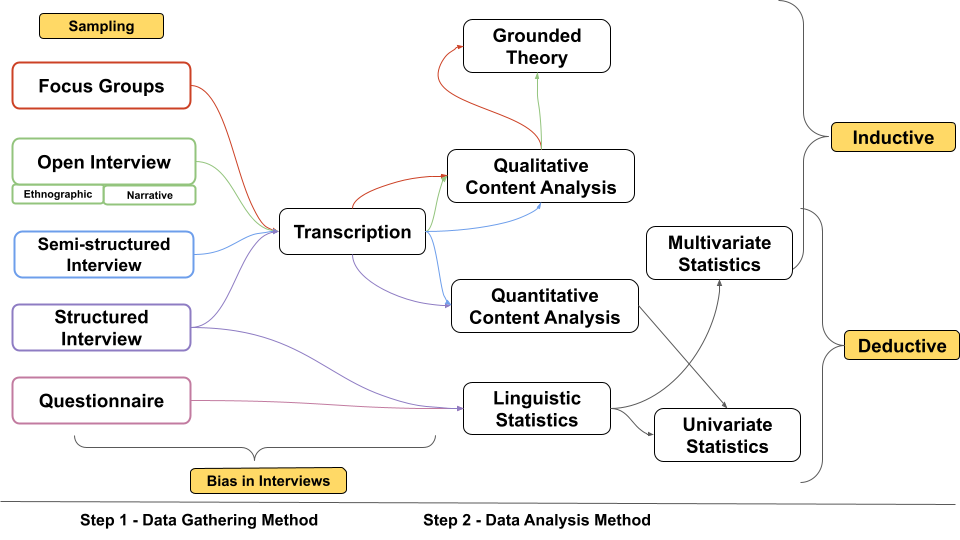Difference between revisions of "Interviews"
| Line 41: | Line 41: | ||
<imagemap>Image:Interview Level 2 Sankey.png|center|1000px | <imagemap>Image:Interview Level 2 Sankey.png|center|1000px | ||
| − | rect 14 | + | rect 14 62 186 108 [[Focus Groups|Focus Groups]] |
| − | rect | + | rect 14 139 191 182 [[Open Interview|Open Interview]] |
| − | rect | + | rect 11 185 101 201 [[Ethnography#Observing_&_Interviewing|Ethnographic Interview]] |
| − | rect | + | rect 106 186 194 201 [[Narrative_Research#Narrative_Interviews|Narrative Interview]] |
| − | rect | + | rect 16 231 191 2752 [[Semi-structured Interview|Semi-structured Interview]] |
| − | rect 14 | + | rect 14 305 188 347 [[Survey Research|Structured Interviews]] |
| − | rect | + | rect 14 377 187 420 [[Survey Research|Questionnaires]] |
rect 282 208 423 252 [[Transcribing Interviews|Interview Transcription]] | rect 282 208 423 252 [[Transcribing Interviews|Interview Transcription]] | ||
rect 465 21 608 69 [[Grounded Theory|Grounded Theory]] | rect 465 21 608 69 [[Grounded Theory|Grounded Theory]] | ||
| Line 53: | Line 53: | ||
rect 453 282 636 331 [[Content Analysis|Quantitative Content Analysis]] | rect 453 282 636 331 [[Content Analysis|Quantitative Content Analysis]] | ||
rect 464 382 608 433 [[Statistics for Surveys|Linguistic Statistics for Surveys]] | rect 464 382 608 433 [[Statistics for Surveys|Linguistic Statistics for Surveys]] | ||
| − | rect 190 469 344 491 [[ | + | rect 190 469 344 491 [[Bias in Interviews]] |
| − | rect | + | rect 41 13 161 38 [[Sampling for Interviews]] |
rect 654 338 798 387 [[An_initial_path_towards_statistical_analysis#Univariate_statistics|Univariate Statistics]] | rect 654 338 798 387 [[An_initial_path_towards_statistical_analysis#Univariate_statistics|Univariate Statistics]] | ||
rect 655 421 799 467 [[An_initial_path_towards_statistical_analysis#Multivariate_statistics|Multivariate Statistics]] | rect 655 421 799 467 [[An_initial_path_towards_statistical_analysis#Multivariate_statistics|Multivariate Statistics]] | ||
Revision as of 08:40, 14 October 2021
This page provides an overview on diverse facets of Interview methodology.
How to find the right Interview method
You may have decided that you want to ask people things for your research, but you don't quite know which approach to choose.
We thought about this, and we decided that in the end, it comes down to two things:
-
Do you want qualitative or quantitative insights?
- Qualitative means that you plan to go into depth with fewer individuals, and understand their worldviews. Qualiltative Interviews lead to results that are hard to compare, but can be of great help when a topic shall be openly and inductively investigated.
- Quantitative means that you are interested in larger numbers of responses which you can calculate with, or in gathering quantitative responses right away, e.g. on a Likert Scale. Quantitative Interviews typically lead to more comparable results, and are often useful for more deductive approaches when your theoretical assumptions are clear.
-
Do you want interactive or non-interactive Interviews?
- Interactive means that you maintain control over the Interview conduction, with pre-determined questions and a strong impact on the questions that individuals respond to.
- Non-interactive means that you rather observe and listen. You have some things you are interested in, but you also want to let the Interviewees speak freely.
If you can decide on these two questions, choose the appropriate Interview method from the following table. You can also have a quick look into the respective entry to check if this is really what you are looking for.
| Interview Method | Short description | Qualitative or Quantitative? | Interactive or non-interactive? |
|---|---|---|---|
| Open Interview | Open, unstructured conversations with individuals | Qualitative | Non-interactive |
| Narrative Interview | Open Interviews with a focus on the creation of narratives through the Interviewee | Qualitative | Non-interactive |
| Ethnographic Interview | Open Interviews conducted in the field during Ethnographic Research | Qualitative | Non-interactive |
| Focus Groups | Group discussions with a focus on the participants’ viewpoints and group interaction and dynamics. | Qualitative | Interactive |
| Semi-structured Interview | Loosely pre-structured conversations with Interviewees. | Quantitative & Qualitative | Interactive |
| Structured Interview | Strongly pre-structured conversations with Interviewees. | Quantitative | Interactive |
| Questionnaire | Written documents used to gather responses from pre-determined options. | Quantitative | Interactive |
What you need to know for your Interview research
After choosing an appropriate method, there are a few things to consider.
We created the following diagram to show you which other Wiki entries we think you should read when you plan to conduct research based on one of the Interview methods. These entries will help you get a better overview of what is important to your research, and will hopefully help you design and shape your methodological approach. The diagram is clickable - just choose a topic that you are interested in!
- The left area shows the different types of Interviews. Select one and follow the respective arrows to the right.
- The central area shows you methods of data analysis that are relevant for the respective Interview methods.
- The yellow boxes highlights aspects of normativity that you should pay attention to.

